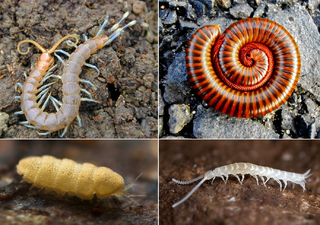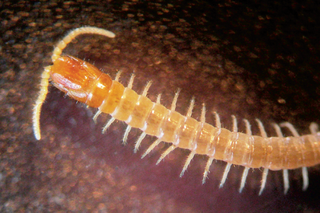
Centipedes are predatory arthropods belonging to the class Chilopoda of the subphylum Myriapoda, an arthropod group which includes millipedes and other multi-legged animals. Centipedes are elongated segmented (metameric) creatures with one pair of legs per body segment. All centipedes are venomous and can inflict painful bites, injecting their venom through pincer-like appendages known as forcipules. Despite the name, no centipede has exactly 100 pairs of legs; number of legs ranges from 15 pairs to 191 pairs, always an odd number. They are predominantly carnivorous.

Myriapods are the members of subphylum Myriapoda, containing arthropods such as millipedes and centipedes. The group contains about 13,000 species, all of them terrestrial.

The Chinese red-headed centipede, also known as the Chinese red head, is a centipede from East Asia and Australasia. It averages 20 cm (8 in) in length and lives in damp environments.

In arthropods, the maxillae are paired structures present on the head as mouthparts in members of the clade Mandibulata, used for tasting and manipulating food. Embryologically, the maxillae are derived from the 4th and 5th segment of the head and the maxillary palps; segmented appendages extending from the base of the maxilla represent the former leg of those respective segments. In most cases, two pairs of maxillae are present and in different arthropod groups the two pairs of maxillae have been variously modified. In crustaceans, the first pair are called maxillulae.

Scolopendra morsitans, also known as the Tanzanian blue ringleg or red-headed centipede, is a species of centipede in the family Scolopendridae. S. morsitans is the type species for the genus Scolopendra.

The Geophilidae are a polyphyletic, cosmopolitan family of soil centipedes in the superfamily Geophiloidea containing the mostly defunct clades Aphilodontidae, Dignathodontidae, Linotaeniidae, Chilenophilinae, and Macronicophilidae.

Himantariidae is a monophyletic family of centipedes in the order Geophilomorpha and superfamily Himantarioidea, found almost exclusively in the Northern Hemisphere. The number of leg-bearing segments in this family ranges from 47 to 181. These centipedes are very elongated with a high mean number of trunk segments and great variability in this number within species. This family contains these genera:

Mecistocephalidae is a monophyletic family of centipedes in the order Geophilomorpha. It is the only family in the suborder Placodesmata. Most species in this family live in tropical or subtropical regions, but some occur in temperate regions. This family is the third most diverse in the order Geophiliomorpha, with about 170 species, including about 130 species in the genus Mecistocephalus.
Linotaeniidae are a monophyletic clade of soil centipedes in the family Geophilidae found mostly in the temperate regions of the Holarctic as well as the south Andes. Species in the clade Linotaeniidae are characterized by a body that usually tapers toward the anterior tip; mandibles with a single pectinate lamella; second maxillae with coxo-sternite usually undivided and claws without projections; forcipular segment short, with tergite remarkably wide, forcipules evidently tapering; coxal organs opening through distinct pores on the ventral surface of the coxo-pleura. The number of legs in this clade varies within species and ranges from 33 to 83 pairs of legs. Compared to most families in the suborder Adesmata, this clade features a modest number of leg-bearing segments and limited variation in this number within each species.

Schendylidae is a family of centipedes in the order Geophilomorpha.
Geophilus arenarius is a species of soil centipede in the family Geophilidae found in northwest Africa, specifically near Annaba, Algeria. This species is frequently misidentified with G. electricus, and as part of the carpophagus species-complex, is closely related to both G. carpophagus and G. easoni, though it differs mainly by lacking a transverse suture on the head and peculiar integumental features (carpophagus-structures) along the trunk, as well as having relatively stouter antennae and forcipular coxosternite. G. arenarius is distinctly smaller at full growth than G. carpophagus, with usually blunter and more sclerotised tubercles lining the intermediate part of the labrum and a minute denticle at the basis of the forcipular tarsungula. It has fewer bristles lining the lateral parts of the labrum than G. easoni as well as a generally higher number of legs and a more greyish coloured trunk. An examination of 36 G. arenarius syntypes indicates that males of this species have 55 pairs of legs, whereas females have 55 to 59 leg pairs, with 57 as the most common number.
Geophilus proximus is a species of soil centipede in the family Geophilidae found in the northern part of the Palearctic and widespread across the entire Baltic basin, though it reaches as far as the Arctic Circle and has been introduced through human agency to northern, central, and eastern parts of Kazakhstan. It was recorded once with certainty in Britain from Unst in the Shetland Islands; distribution in the rest of Europe is difficult to assess because of frequent misidentifications of the species. Populations from northern Europe are mostly parthenogenetic.

Himantarioidea is a monophyletic superfamily of soil centipedes in the suborder Adesmata containing the families Oryidae, Himantariidae, and Schendylidae. It's characterized by labrum fringed by marginal denticles, epipharynx with clusters of spear-shaped sensilla on the clypeal part, and telopodites of the second maxillae with a distally flattened pretarsus.

Geophiloidea is a superfamily in the order Geophilomorpha and suborder Adesmata containing the families Zelanophilidae, Gonibregmatidae, and Geophilidae. It's characterized by an epipharynx with a bilobate border separating the clypeal and the labral parts, hypopharynx with spines extending to most frontal and ventral parts, and mandibles with a single, pectinate lamella.
Geophilus impressus is a species of soil centipede in the family Geophilidae found all over Europe, and has also been recorded in North Africa. It lives frequently in endogean habitats; in Sardinia it's found mostly in Quercus ilex woods, but also in Mediterranean shrub, open habitats, and maquis. It lives anywhere from sea level to 1700 meters above it, sometimes in caves.
Geophilus aetnensis is a species of soil centipede in the family Geophilidae found in Europe and northern Asia, excluding China. As described by Verhoeff in 1928, it grows up to 28 millimeters and has 53 leg pairs, 4 sensory setae each on the 2nd-4th front sternites, slightly notched maxillae, and very faint sternal pits on the thorax as well as poorly developed sternal grooves.
Geophilus mordax, also called the pitted soil centipede, is a species of soil centipede in the family Geophilidae found in North America, especially Indiana, Arkansas, Louisiana, North and South Carolina, and Florida. It grows up to 50 millimeters in length, though it averages 25–40, has 49–53 leg pairs in males and 49–57 in females, and is bright red in color. G. mordax also bears 3–5 labral teeth, a short and robust apical claw of the second maxillae, an exposed prebasal plate, and a large, consolidated sacculi.
Geophilus richardi is a species of soil centipede in the family Geophilidae found in France, Italy, and the Ionian Islands. Females of this species have 33 pairs of legs; males have 29 or 31. This species is one of only two in the family Geophilidae to include centipedes with as few as 29 leg pairs. This species grows up to 10 millimeters long, has no carpophagus pit or pore-fields, and has a gradually tapering, curved pretarsus of the second maxillae. G. richardi lacks typical ventral pores between 2–4mm. The sternites instead bear a small number of pores between 0.5–1mm that differ from micropores, which are unbounded by a cuticular ring. These are possibly the remnants of typical ventral pores, their smaller size being a byproduct of overall miniaturization.
Geophilus bosniensis is a species of soil centipede in the family Geophilidae endemic to Bosnia and Herzegovina. It grows up to 30 millimeters and has 75 leg pairs, as well as sternites unseparated in the median but with a suture line, and sternal pore areas in the trunk segments only. Overall, the identity and phyletic position of this centipede are uncertain.
The centipedes or Chilopoda are divided into five orders, which are grouped into two subclasses, Pleurostigmomorpha and Notostigmomorpha, the latter of which comprises only one order, the Scutigeromorpha.











